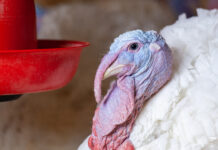
Although some regions show temporary stability, the continued circulation of the virus among wild birds keeps the risk high for poultry holdings.
The latest Risk Assessment on Highly Pathogenic Avian Influenza H5 (Clade 2.3.4.4b), published by Germany’s Friedrich-Loeffler-Institut (FLI) on 20 October 2025, confirms that HPAI remains present across Europe, with dozens of outbreaks recorded in poultry and wild birds during the past 12 months.
Current situation in Europe
Between October 2024 and October 2025, a total of 64 outbreaks of HPAI H5 were reported in poultry and captive birds across 15 European countries, according to notifications to the Animal Disease Information System (ADIS) and WOAH.
Germany recorded the highest number (15), followed by Spain (13), Poland (10), France (5), Italy (4), and Bulgaria (3). Two cases each were detected in the United Kingdom, Denmark, and Portugal, while single detections occurred in Czechia, Slovakia, North Macedonia, Lithuania, the Netherlands, Norway, and Ireland.
Most cases involved the H5N1 subtype, with two untypeable H5 detections in France.
In addition, 106 cases of HPAI H5N1 were confirmed in wild birds.
The largest numbers came from Spain (25), United Kingdom (22), Norway (15), and Germany (11), followed by Austria (8), France and Portugal (5 each), Latvia, the Netherlands, and Denmark (3 each), Italy (2), and isolated detections in Sweden, Hungary, Iceland, and Poland (1 each).
Further detections included five H5N5 infections (Norway = 1; Iceland = 4), single untyped H5 in Iceland and Belgium, and one untyped H7 in Portugal.
No HPAI H5 cases in mammals were reported in Europe during the period.

Post-publication update (FLI statement – 24 October 2025)
In a communication published on its official website on 24 October 2025, the FLI reported an increased risk of new outbreaks in poultry and a growing number of detections among wild birds, especially cranes.
This indicates renewed viral activity following the mid-October assessment and underlines the need for reinforced vigilance across Europe’s poultry sector.
Germany: vigilance remains essential
Within Germany, multiple outbreaks in poultry and captive birds were reported, most likely linked to contact with infected wild birds or environmental contamination.
Although outbreak numbers were lower than in previous peak years, the virus continues to circulate in wild bird populations, maintaining a constant risk of spillover.
The FLI advises poultry keepers to maintain strict biosecurity—particularly during the autumn migration season—when the probability of virus introduction is elevated.
Global overview
Beyond Europe, HPAI H5 detections continue across Asia, Africa, and North America, highlighting the global spread of clade 2.3.4.4b.
According to FLI, migratory movements of wild birds remain the primary pathway for long-distance transmission.
Conclusion
The FLI concludes that, despite seasonal variations, HPAI H5 remains widely circulating among European wild birds, creating a persistent risk for poultry holdings.
While the overall number of outbreaks has not risen dramatically in 2025, continued vigilance and strict on-farm biosecurity remain essential to prevent new incursions.
Sources:
Friedrich-Loeffler-Institut (FLI), Risikoeinschätzung zur Hochpathogenen Aviären Influenza H5 (HPAI H5) Klade 2.3.4.4b, Stand 20 October 2025.
FLI official update, 24 October 2025 (“Erhöhtes Risiko neuer Ausbrüche bei Hausgeflügel – Kraniche besonders betroffen”).
















